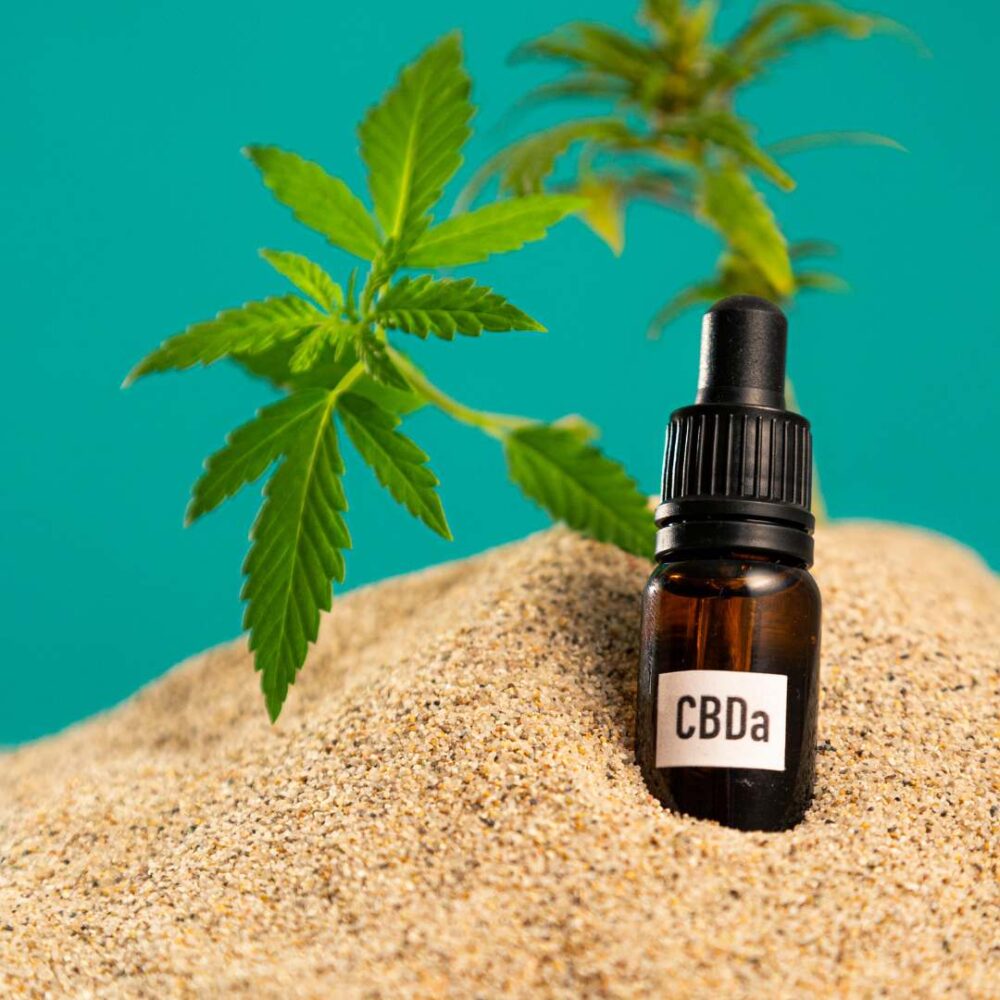
CBD, or cannabidiol, has become increasingly popular for its therapeutic benefits in recent years. However, there is an overlooked bioactive compound also found in the hemp plant that is also worth paying attention to - CBDA. This class of acidic cannabionids, which are the original form found in the hemp plant, are becoming widely studied in the scientific community as their enhanced medicinal benefits.
This guide will take a closer look at what CBDA stands for, how it differs from CBD, and the potential health benefits it may offer. We will also explore how to incorporate CBDA into your routine. By the end of this guide, you will better understand these acidic cannabinoids and be able to decide if it is right for you.
Article Highlights
- CBDA (cannabidiolic acid) is the most abundant cannabinoid in the hemp plant
- CBDA is the precursor to CBD, and converts to CBD when exposed to heat
- Due to the difficulty of purifying acidic cannabinoids, CBDA benefits are only now being discovered.
- New research shows that CBDA benefits may far outweigh CBD due to its enhanced absorption and anti inflammatory properties.
What Does CBDA Stand For, and How Is It Different From CBD?
There are hundreds of cannabinoids found in cannabis sativa, each one presenting its own unique qualities. One of these is CBDA which stands for cannabidiolic acid. It is a chemical precursor to CBD. It is found in raw cannabis plant and converted to CBD through decarboxylation. Decarboxylation is the process of heating the CBDA molecule. It causes the molecular structure of CBDA to change, resulting in CBD.
How are cannabinoid acids made in the hemp plant?
As an example, an initial process for how acidic cannabinoids are made: In the flower of the hemp plant, cannabinoid enzymes in the buds create cannabigerolic acid (CBGA), which is the mother compound to all the other cannabinoids. CBGA in turn, is converted into three different combinations of the three major cannabinoid precursor compounds by their respective enzymes:- Tetrahydrocannabinolic acid (THCA)
- Cannabichromenic acid (CBCA)
- Cannabidiolic acid (CBDA)
In the hemp plant enzymes do not convert their acidic cannabinoids into their neutral forms (e.g. CBDA into CBD). This only occurs after the hemp flower is exposed to heat or extracted for cannabinoids oil.
How CBD oil is made from CBDA
Cannabinoids are extracted from the hemp plant, first by a crude extraction process, followed by a purification process to produce a high purity cannabinoid oil. During the crude extraction and purification steps, heat is used, which converts the CBDA into CBD in a process called decarboxylation.The main difference between CBDA and CBD is that CBDA appears in higher concentrations in raw cannabis. On the other hand, CBD is more prevalent in cooked or heated cannabis. CBDA also has a slightly different molecular structure than CBD, containing a carboxyl group which confers unique properties to acidic cannabinoids.
New technologies pioneered by Natural Dos has allowed for the purification of acidic cannabinoids found in the hemp flower, without using heat. We have termed this Natural Spectrum CBDA oil, which contains all the acidic forms from the cannabis plant.
The Science Behind CBDA: How It Works
CBDA, similar to CBD, interacts with the body's endocannabinoid system (ECS). The ECS is a network of receptors and associated endocannabinoid molecules that regulate various physiological processes. This can include appetite, mood, and pain perception. CBDA is thought to interact with the CB1, CB2 receptors, and the endocannabinoids found in the body. When CBDA binds to these cannabinoid receptors, it may regulate several other physiologic targets involved in health and healing.
The Potential Health Benefits of CBDA
While both health providers and research team agrees that CBDA is still in its early stages, some evidence suggests that it may offer various health benefits. Potential CBDA benefits include the following:- Analgesic and Anti-inflammatory Effects: Preliminary research into CBDA and COX-2 indicates the potential anti-inflammatory properties of CBDA. This may make it helpful in treating inflammatory diseases and may help relieve chronic pain.
- Anti-nausea: Research shows that CBDA is effective in reducing nausea and vomiting in animal studies.
- Antitumor: CBDA has been shown to inhibit the growth of certain types of cancer cells such as breast cancer cells in laboratory studies. CBDA work by blocking the activity of certain enzymes that promote tumor growth.
- Antidepressant: CBDA has been shown to have antidepressant properties in animal studies, which may make it helpful in treating depression. Consuming CBDA will not cause feelings of being high, but it is thought to increase feelings of peacefulness. This is due to its effect on serotonin receptors, such as 5HT1A, which is a target of most SSRIs.
- Boost Immune System: Human research showed that CBDA my benefit the human body by promoting balance in biological system around the ECS, thus boosting the immune system. Many of the endocannabinoid system receptors are located in the cells of the immune system, and help regulate their functions.
How to Incorporate CBDA Into Your Routine
If you're interested to buy CBDA products, such as CBDA drops, tinctures, or gummies, there are a few ways to incorporate it into your routine.- You can start taking a low dosage and gradually increase it as your body adapts to the effects of CBDA. We recommend starting at 25-50mg per day.
- CBDA drops or tinctures can be added to your favorite beverage or food, such as coffee, tea, or a smoothie. Putting CBDA tincture under the tongue is the fastest way to absorb CBDA oil.
- You can also apply CBDA topically by adding it to your lotion or cream for a localized chronic pain relief.
- Take CBDA at a specific time of the day, such as an hour before bed. By doing this, you will be able to enhance its potential benefits for sleep.
- Consult with a health provider before incorporating CBDA oil into your routine especially if you have any concerns or underlying health conditions.
- Immediately stop consuming CBDA oil if you notice any adverse effects, such as nausea, dizziness, or allergic reactions.

CBDA vs. CBD: Which One Should You Choose?
When choosing between CBD and CBDA oil, the decision ultimately comes down to personal preference and what you want to achieve. CBD is more widely available and has been studied more extensively.On the other hand, CBDA may be a better choice for those looking for a more potent anti-inflammatory or anti-nausea effect. It may also be a good option for those seeking an alternative to traditional antidepressants or looking for anxiety and stress relief.
It's also worth noting that CBD and CBDA are natural products that can be used together. Some CBD and CBDA consumers may find that using them together is more effective than using either alone.
Takeaway
In conclusion, CBDA stands for cannabidiolic acid. It is still overlooked bioactive compound with a great potential therapeutic benefits in human health. This non-psychoactive compound found in the hemp plants is known for its potential anti-proliferative and anti-inflammatory properties. While more research is needed to fully understand the benefits of CBDA, early studies suggest that it may be a promising alternative for those looking for relief from certain conditions.If you're interested in incorporating CBDA into your routine, try Natural Dos today!
As always, it's important to consult with a healthcare professional if you have a history of liver complications or are on medications. Look for a brand that offers safe and reliable product and start with a small dosage. As the interest in CBDA grows, we can expect to learn more about this unique compound and its potential benefits.

